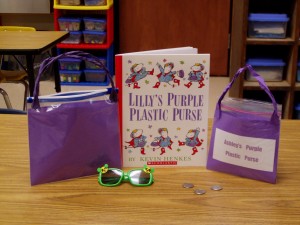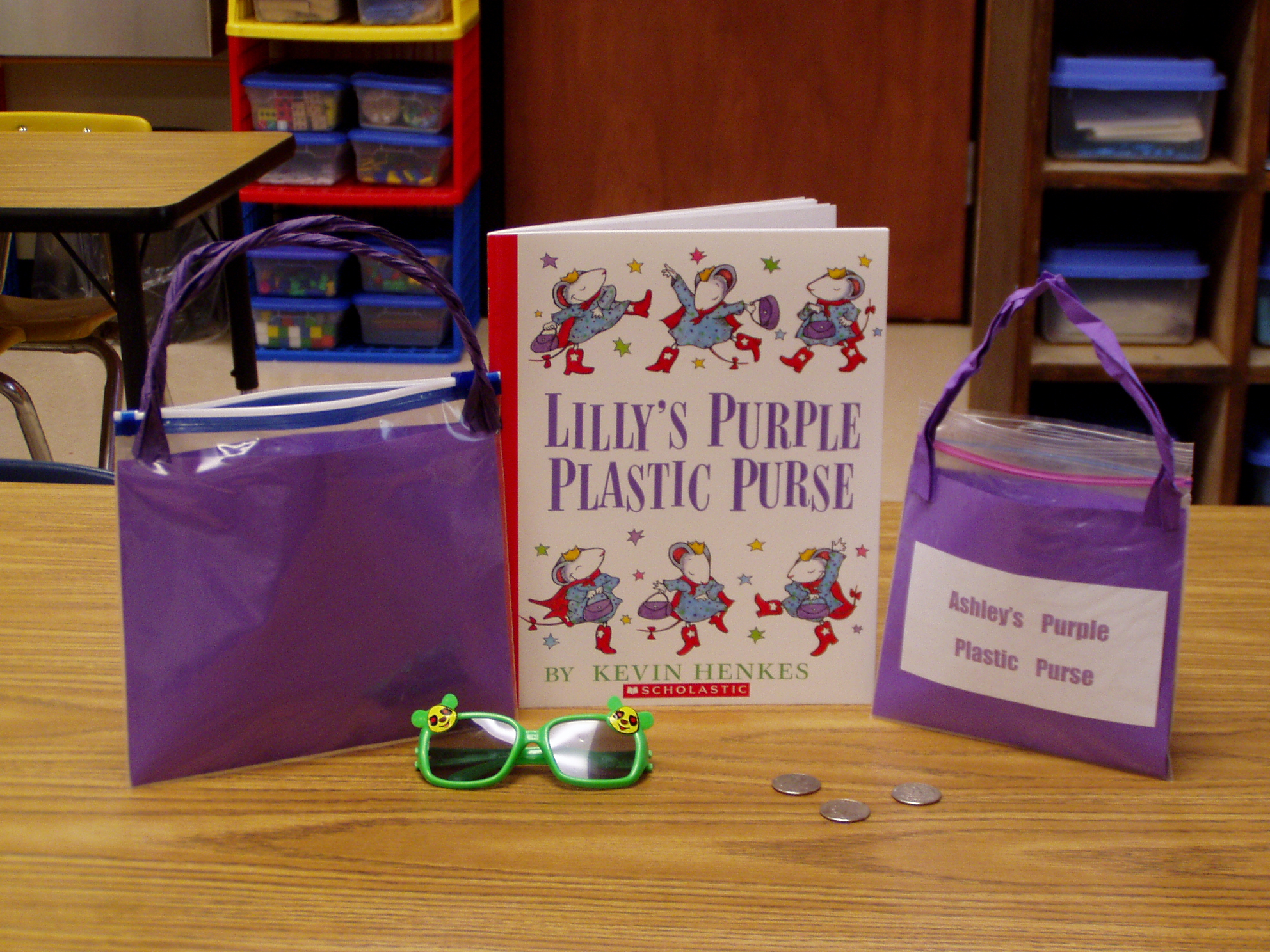 Love me some Kevin Henkes… A few years ago Teaching Heart did a contest and many teachers submitted ideas and printables to match various books by Kevin Henkes. You can see all the ideas by clicking here! There are so many wonderful ideas for teachers with Teaching Hearts!!! Below are some ideas to match Lilly’s Purple Plastic Purse which happens to be a favorite of mine!
Love me some Kevin Henkes… A few years ago Teaching Heart did a contest and many teachers submitted ideas and printables to match various books by Kevin Henkes. You can see all the ideas by clicking here! There are so many wonderful ideas for teachers with Teaching Hearts!!! Below are some ideas to match Lilly’s Purple Plastic Purse which happens to be a favorite of mine!
Fold purple paper and cut to fit inside baggie
Insert in baggie with fold at
the bottom
Twist thin strips of paper to make handles-attach with glue
dots
I have attached sheets I made for story recall, counting sets, and
sorting coins.
Leave plain or
make a personalized label
Ashley’s Purple
Plastic Purse
You could put in “movie star sunglasses” and/or coins to practice coin recognition.
Students could draw pictures or cut out magazine pictues of
what they would keep in a purse.
Renee
Liles/Arkansas
-This story is about Lily’s most prized
possession and a great September activity to learn more about your students.
After reading this story, talk about “prize possessions.” Discuss how Lily’s
purse was so special to her. Then, I share one of my prized possessions from my
childhood and read a description I have written about my object. Then, I have
students begin writing a description about one of their prized possessions. I
provided copies of a paperbag (for boys) and a larger purse (for girls) so the
students can draw their prized possessions after they write their final copies.
Also, I send a letter home to parents requesting students bring in their most
prized possessions for the writing activity. Ask that these possessions be
placed in a labelled brown paper bag for safe keeping. We then have a class
sharing day. Students read their writing and show their actual possessions.
After sharing day, I post students’ papers & pictures on a bulletin board.
Renee Cooperman /New York
-I teach first grade and this is truly one of
my favorite stories! I always share this story during the first few weeks of
school.
-Student nametags are taped onto their desk. After sharing and
discussing the story, Chrysanthemum, I go to the board and draw a box (to
represent my piece of plain paper) then write my name at the top. I tell the
students we are going to count the number of letters in my name. After this, I
ask students to count the letters in their name then whisper it to their
partner. I ask for volunteers to share how many letters they counted and call on
several students. I can recognize which student(s) might need additional help.
After students count and share, then I draw ___ and put space for each letter in
my name on the page; we are counting my letters together and I am modeling what
students are to do at the board while students count and watch me draw the
blanks. Then several students volunteer for me to put their name on the board as
another example. Each student is given plain paper. They write their name at the
top of their paper. Pencils down. I ask students to count the letters in their
name and again whisper it to their partner. Then model on the board what
students with 2 letters, 3 letters, 4 letters, etc. and have those students to
draw their blanks while we are working together then put their pencil down after
they are finished. The only students who pick their pencils up are the ones with
that number of letters in their name, and then I go to the next number. After
all numbers are shared and their partner checks their paper to see if it is
correct, I then pass out magazines, advertisement papers, etc. They are to find
then glue the letters that are in their name on individual lines, in the correct
order. After students have found the letters, they can then either draw a
picture with the beginning sound under the letter or cut pictures from the
magazines, advertisements, etc. We share our pages with the class and then we
make a class book with the papers. The book is titled How many letters? When I
make class books, I bound then with yarn or silver rings and they rotate home
with each student until everyone has had a chance to share it with their family.
Kelly
Brown/NC
-I love to read the story Chrysanthemum by
Kevin Henkes at the beginning of the year. It’s a great story to read when you
would like everyone to learn their names. After reading the story Chrysanthemum
with my class, I always start a discussion about our names and what our names
mean to us. I explain that at times, our names can even describe us. I model a
free form map on the board with the name of Chrysanthemum,,,, or even better
“Mickey Mouse”.(They seem to know that character well.) Then, I have the
children give me ideas of things they think of when they think of Mickey Mouse
or what describes him. Immediately, the class starts participating and calling
out…little mouse, friendly, pluto, Disney World, etc… On the board I write
the name in the center and then I map out from the name. I tell the class they
can either write words around the name or draw pictures that describe the name.
Once I’m done modeling how to do a free form map on the board, I pass out a big
sheet of white construction paper to the class and have them create a free form
map around their names. Their maps always come out super nice, and bright. I
tell the children that their maps must be in color and full of details. I tell
them to draw or write things like where they were born, their hobbies, pets,
friends, personalities, siblings, favorite color, etc… Here is an example of a
free form map I made with my name just so you can see it and have an idea of
what it looks like. Hope you like my idea, my children always seem to love it.
It works great with 2nd and 3rd grade. I just wish I would have kept a sample
from the ones my kids from last year.
Thank
You,
Ms. Quintero
(2nd Grade, Miami, FL.)
-Using various sources on the web, I created
two poster/transparency templates for Chrysanthemum. I also created a letter
home to parents asking their for their help in an extension activity.
Files
(pdf)
Shana
Swindle/Mississippi
-Read the story to the class and chart ideas
about times when students did something that they regretted. You may even want
to share a time like that of your own. Send them to their seats and let them
write about a time like that on the attached printable. You could copy it on
purple paper to make it even cuter.
Add different coin amounts
(depending on your grade level) to the money page and have students practice
counting money.
Use the graphic organizer to talk about the story
elements.
Make purple construction paper purses in
PDF’s
Lynne
McLaughlin/Texas



